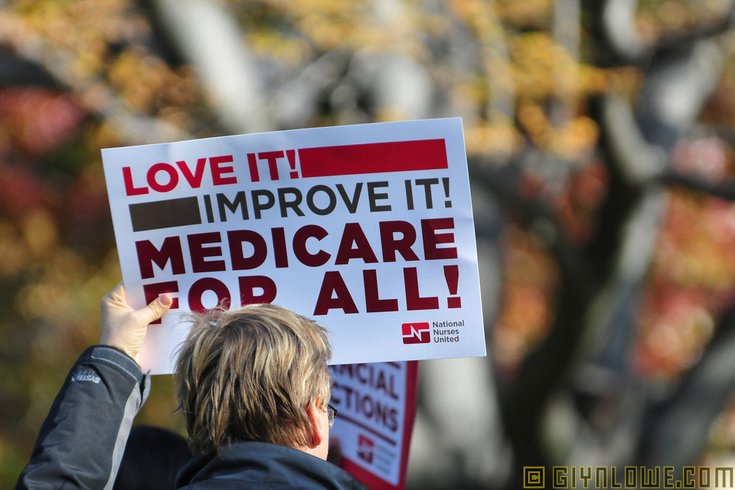
February 28, 2019
 Glyn Lowe PhotoWorks/via Flickr Creative Commons
Glyn Lowe PhotoWorks/via Flickr Creative Commons
A rally participant holds a "Medicare for all" sign during the National Nurses United for an International Day of Action in Washington, D.C., in this November 2011 file photo.
Members of the House on Wednesday offered their version of a “Medicare-for-all” bill that is broader than what’s been put forth by Sen. Bernie Sanders (I-Vt.), whose 2016 presidential run pushed the issue into the political mainstream.
Rep. Pramila Jayapal (D-Wash.) and Rep. Debbie Dingell (D-Mich.) unveiled the “Medicare for All Act of 2019,” which redefines what the change in health care coverage might mean. The specifics included in the bill could play a role in the upcoming Democratic presidential primary campaign because candidates seeking support from the party’s progressive wing leverage the phrase. But often, they use it to mean various things.
Is this bill so different from Medicare-for-all proposals that have come before? And why would those differences matter? Here are the essential takeaways:
In terms of the policy 411, the Jayapal-Dingell bill includes provisions not in other proposals.
In many ways, the proposal sounds familiar: The government would establish a health plan that pays for basically all forms of medical care for all citizens. That’s how it gets the moniker “Medicare-for-all.”
Under this plan, patients would not be responsible for any cost sharing of medical expenses, and the government coverage would include hospitals, doctors, preventive care, prescription meds and dental and vision care. Private insurers would not be allowed to sell plans that compete with the government program.
Senior citizens would be folded into the new Medicare plan, which would be more generous than their current coverage, and the government would make sure any medical care they are getting is not disrupted. The bill leaves two other government health care payers intact: the Veterans Health Administration and the Indian Health Service. Beneficiaries enrolled in these programs would have a choice of enrolling in the new Medicare-for-all plan or sticking with their current coverage.
Just like the Sanders bill, the House legislation covers what it calls “comprehensive reproductive health.” Backers say it is meant to cover abortion — a controversial provision. Right now, government-funded health plans are legally prohibited from providing funds for abortions.
There are differences, too. For one, the transition to the new Medicare-for-all system would take place over two years, which would be a fast turnaround for a substantial task. Sanders’ bill suggested a four-year transition.
The biggest difference: This House vision of Medicare-for-all would also cover long-term care. That isn’t part of the Sanders bill, and it is not covered by Medicare. But for people with disabilities and the elderly, it’s a significant benefit — and one that can get very expensive to pay for out-of-pocket. (The Affordable Care Act included a long-term care provision that was eventually scrapped because of its high cost.)
The House bill also would take a swipe at high prices for prescription drugs by empowering the government to negotiate prices directly with manufacturers and to take away and reissue drug patents if such efforts faltered. This idea, known as “compulsory licensing,” has appeared in drug-pricing bills, but not in other Medicare-for-all legislation.
And the bill wades into one of the hottest Medicare-for-all controversies: the role of private health care. Notably, it permits it. Private plans can cover services not included in the single government health plan. Doctors can also refuse to participate in the program and charge patients cash for medical treatment instead.
“Whether there’s someone out in Beverly Hills who sees the stars and doesn’t partake — that would be possible,” said Dr. Adam Gaffney, a doctor and president of Physicians for a National Health Program, a single-payer advocacy group that supports the legislation. “The way the whole program is structured is to really make it such that that’s a very insignificant overall phenomenon.”
And the legislation takes on wonkier questions, like health care costs — proposing so-called global budgets that set a firm amount the federal government would pay for hospitals, for instance, as a strategy to bring down spending.
Still, the legislation leaves a lot of meaningful details open to interpretation.
Three big ones: what precisely would be covered, what doctors would be paid and how the program would be financed.
Generally, Medicare-for-all would provide “comprehensive benefits,” accounting for health care needs as “medically necessary or appropriate.” That means covering hospital and doctor visits, but also, for instance, mental health, maternity services, addiction treatment, pediatrics and medications.
Where it gets tricky is determining which specific services qualify as “necessary.” Sometimes that’s obvious — insulin for diabetics or a cast for a broken leg.
In other cases, it’s not as clear. Examples include politically controversial treatments, like gender confirmation surgery. Many experts do say the procedure is an important option for people with gender dysphoria. But specific components of it are sometimes deemed cosmetic or unneeded — often by those skeptical of the treatment to begin with.
There are also reconstructive surgeries that provide medical value, but may be deemed cosmetic.
The Department of Health and Human Services would have significant discretion in interpreting what specific services are “medically necessary.” That means political leanings or scientific debates could sway what’s covered, even from administration to administration.
“Reasonable people could disagree on certain things,” Gaffney acknowledged.
The legislation also spells out steps for determining how to pay doctors — a tricky issue, since doctors often complain that traditional Medicare pays them less than does private insurance. But the bill doesn’t set up a reimbursement system.
Of course, there’s the question of how the U.S. pays for the new program. Studies suggest Medicare-for-all would bring down national health care costs. Currently, though, much of that health spending is borne by the private sector. Under the Jayapal-Dingell bill, the money would have to come out of taxpayer dollars.
That would mean new taxes, and that’s a subject that does not appear anywhere in the Jayapal-Dingell bill. (Jayapal has said she will put out a separate list of potential taxes that could finance her single-payer proposal. Sanders also used this strategy — a separate list of “pay-fors” — to make a case for his bill.)
The bill could resonate throughout the 2020 campaign.
The House bill keeps a spotlight on the Medicare-for-all issue — requiring Democratic presidential primary candidates to answer more questions and spell out stances on this particular policy.
That could create some land mines. Medicare-for-all is controversial, and already major health industry groups have ramped up opposition to the broad idea. This bill’s specific provisions, such as its coverage of abortion, would add more adversaries. Its long-term care coverage would further drive up its multi-trillion-dollar price tag
But Robert Blendon, a health care pollster at the Harvard T.H. Chan School of Public Health, pointed out that addressing concerns such as the long-term care benefit could add to the measure’s political muscle. It could make the idea more attractive to older voters, who otherwise might be hesitant to change their coverage but who do turn out disproportionately to vote in primaries.
That dynamic, he said, could skew primary results to favor candidates who endorse Medicare-for-all, as opposed to more moderate Democrats who have distanced themselves from the issue. (In a general election, he noted, costs could certainly diminish that support.)
“The long-term care piece is unbelievably significant,” he said. “It surely will help [progressives] with older voters.”